




Another book about the VW Bus? Yes! No other vehicle has given rise to so many stories. Not only because it has been one of the most popular vehicles in its class for 75 years, but because it is not just used, but loved. The VW Bus is more than an automobile: it is a member of the family. With a story behind every one, I could have written 1,111 chapters! But that would have made this book too big and heavy, so I have selected 111 stories from the VW Bus universe. These range from the history of the different models, to extraordinary vehicles, and stories about people who have a special association with this incredible vehicle.
My own life is inseparable from the VW Bus. Aged 17, I got my first T3 and was bitten by the bug. Later, I was able to make a job out of my hobby, so almost everything revolves around “the vehicle in my life”. The VW Bus is the best accomplice imaginable for an automobile adventure. Through the bus I have made friends all around the world, and had experiences that were probably only possible with this vehicle. I have spent countless nights in a VW Bus, sometimes in places where we could stay only because of the vehicle itself. The VW Bus opens people’s hearts, and offers unimaginable opportunities.
Immerse yourself in the fascinating cosmos of the world’s most versatile automobile. Take inspiration for discov ering the planet and its delightful people in a VW Bus. And don’t wait until you retire: every day without a bus is one without opportunity for adventure. Whether a small escape from everyday life or travelling to a distant place, what counts is the journey, not the destination. With a VW Bus, relaxation begins as soon as you get inside –just lower the arm rests and enjoy the view. And if you see a VW Bus coming towards you, wave with your little finger and thumb extended. Hang loose and keep on rolling!
Christian SchlüterThere are two fixtures in the history of the VW Bus: Ben Pon and the flatbed truck. The Pon family is an insti tution in Amersfoort in the Netherlands, today as in the past.
It all started in 1898 with an all-purpose store founded by Mijndert, taken over in 1928 by Ben, his first son, and Ben’s brother Wijnand. In 1931 they established Pon’s Automobile Trading, importing trucks and cars from Europe and America. At a trade fair in 1939 they met Ferdinand Porsche, who showed them the KdF car, the forerunner of the VW Beetle. After World War II, Federal Trucks were the company’s mainstay. Until 1948, the brothers sold almost 10 times as many trucks as cars. Initially the war ended their efforts to become the VW importer for the Netherlands, but on 8 August, 1947, the time had come: their company became the world’s first Volkswagen importer.
On a visit to the factory in Wolfsburg, Pon saw a so-called Plattenwagen, on which the driver’s seat is placed at the back above the engine, behind a long, flat surface for loads. The vehicle was ideal for transporting heavy goods through the factory. Pon was fascinated, and sketched an automobile that had its engine at the back, like the Beetle, but was a delivery truck. This sketch was long thought to be the first and only basis for the prototype of the 1949 VW Bus, but research has demonstrated that several people were working at the same time on the idea of a light commercial vehicle – just like Mercedes and Benz in their day.
With a free-hand drawing of the design, Pon is said to have convinced Heinrich Nordhoff that he should make a transporter on the basis of the VW Beetle, with variants suitable for passengers and goods. This combination of bus (with BU) and delivery van (“Lieferwagen”, with LI) was later the model for the concise but affectionate German name for the VW Bus: “Bulli”.
The starting signal for VW’s Type 2. The flatbed truck was a solution for transport within the factory, and provided the idea for the VW Bus.

As early as 1949, the idea of producing a delivery van (Type 2) alongside the Beetle led to the first prototypes, and in early 1950 the VW Transporter was born in Wolfsburg. On 8 March, 1950, manual production was switched to series production; while initially turning out just three Transporters a day, this was the first step towards global triumph. The name “delivery van” was changed to “Transporter”, and the growing economy gained its first, spacious, load-carrying mule. With a large rectangular space for goods, the self-supporting body was extremely well-suited to the needs of tradesmen. Yet the vehicle was still very compact, and had a top speed of almost 80km/h. With its indestructible technology and great reliability, it soon became a hit.
As demand for both goods and passenger vehicles increased, VW put a minibus alongside the Transporter, recog nisable by its three side windows. Inside were up to nine seats in three rows, and cladding on the walls: perfect for a family or small group. For small businesses in manual trades that wanted to get employees to a work site cheaply, the minibus was available in a version called the Kombi, which lacked interior cladding. Public institu tions liked the Kombi because it could be quickly and easily customised. For fire, police and ambulance services, this was done in the factory.
In 1952, VW pulled the next ace from its sleeve: the pickup. With a 2.6 metres by 1.6 metres open cargo space, there was no longer any bodywork to restrict load height or obstruct loading from ramps, which were usually high at that time. There was also a lockable compartment beneath the cargo surface to store tools, that quickly earned the nickname “treasure chest”. While the first pickup seated only three people, an extended cabin later doubled this, with a smaller space for goods. This versatility made the VW perfect for almost any purpose.
This T1 (chassis number 20 1880) rejoices in the name of Sofie and is probably the world’s oldest T1 with certified roadworthiness.

Sales of the VW Bus rose steadily in the mid-1950s. Volkswagen continuously optimised its bestselling model, which from 1955 was termed the T1b – identifiable by the projecting roof at the front, which considerably improved interior ventilation. The engine hood became smaller, with the lower engine space allowing more load capacity. Engine power increased to 30 HP, improving acceleration. Over time the T1 got increasingly powerful engines generating up to 44 HP, enabling speeds of over 100km/h.
In 1956, production transferred to the new Transporter factory in Hanover. The range of models continued to grow. From 1958, the double-cabin version seating up to six people with space for loads was available straight from the factory. 1961 saw the introduction of the enlarged van. Its high roof meant an interior height of 1.75 metres, with cargo volume increased to six cubic metres. Hatch doors were as tall as the vehicle, which enabled both light and bulky goods to be loaded easily.
In summer 1963, the VW Bus got a last facelift before the new model was introduced and it became the T2. More than one million had already been produced when this update occurred. The Transporter known today as the T1c got a rear hatch with a further increase in size, and the hatch doors at the side were replaced with practical sliding doors.
Production of the T1 in Germany ended in 1967, totalling almost 1.8 million vehicles. Manufacture of the old model then continued in Brazil. Until 1975 the Transporter retained its characteristic split windscreen, and the side walls of the T1 were produced unchanged until after 1995. As the proportion of locally made components rose, the Brazilian T1 differed from its German cousins in several ways – sometimes posing a challenge for owners seeking spares. Wherever the T1 was produced, they put smiles on faces of drivers and passers-by to this day.
At a glance the “new” T1 can be identified by its larger, flatter indicators.
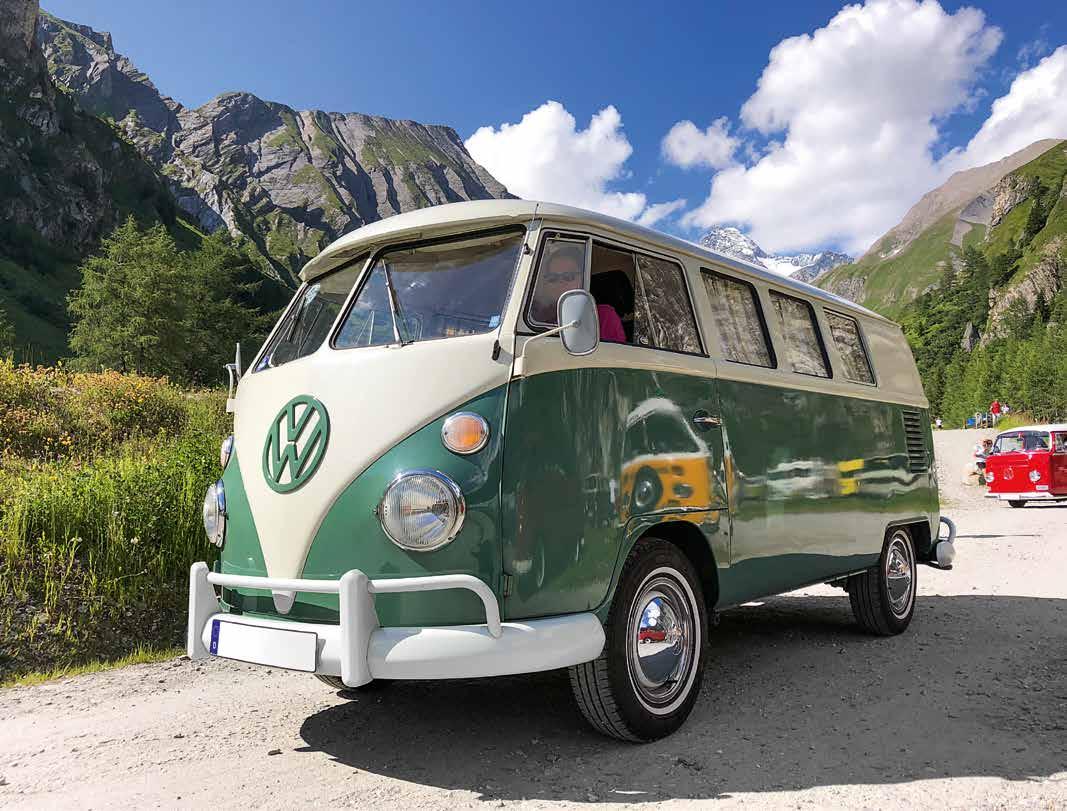
After 17 years of production, the time came for an overhaul of the VW Transporter and Bus. The concept remained unchanged: there was space for goods between the air-cooled rear engine and the seats in coach-box style over the front axle in the driver’s cabin. But the engineering and design saw noticeable changes. The two small, flat front windscreens became a large, curved one. Its bow shape resulted in the nickname “bay window” in the English-speaking world. The other windows became much larger, and the useful vent window in the driv er’s cabin was retained.
To increase cargo space, the Transporter was lengthened by 14 centimetres. The round indicators became angular and were placed lower. The sliding doors – optional on the T1 – were standard, and ride comfort improved thanks to new suspension. The flat construction of the engine allowed more space inside, and loads did not have to be lifted high to go in the back. The dashboard was more car-like and driver-friendly, and had an upholstered shelf.
As with the T1, the people at Volkswagen knew that the success of this VW was due to the variety of different models. Alongside the basic van and Kombi, from the very start a variant with a fibreglass high roof and a pickup, 10 centimetres longer with either one row of seats or two (the double cabin), were also available.
As the “special model” or Deluxe (USA), colloquially known as the Samba, was a great success, a luxurious version was also planned for the T2. VW therefore launched the Clipper – a less elaborate vehicle than the T1 Samba. It lacked roof windows and a folding roof, but to compensate had a white roof with steel winder, and many chrome parts. Use of the name Clipper was not well-received by Pan Am airline, which had secured the rights to the name, so VW returned to simply “seven-seater” or “eight-seater”. This did nothing to affect the T2a’s popularity, however.
Thanks to its round windscreen, the T2 was also known as the “bay window”. If, as here, it has low-placed indicators, it is a T2a.
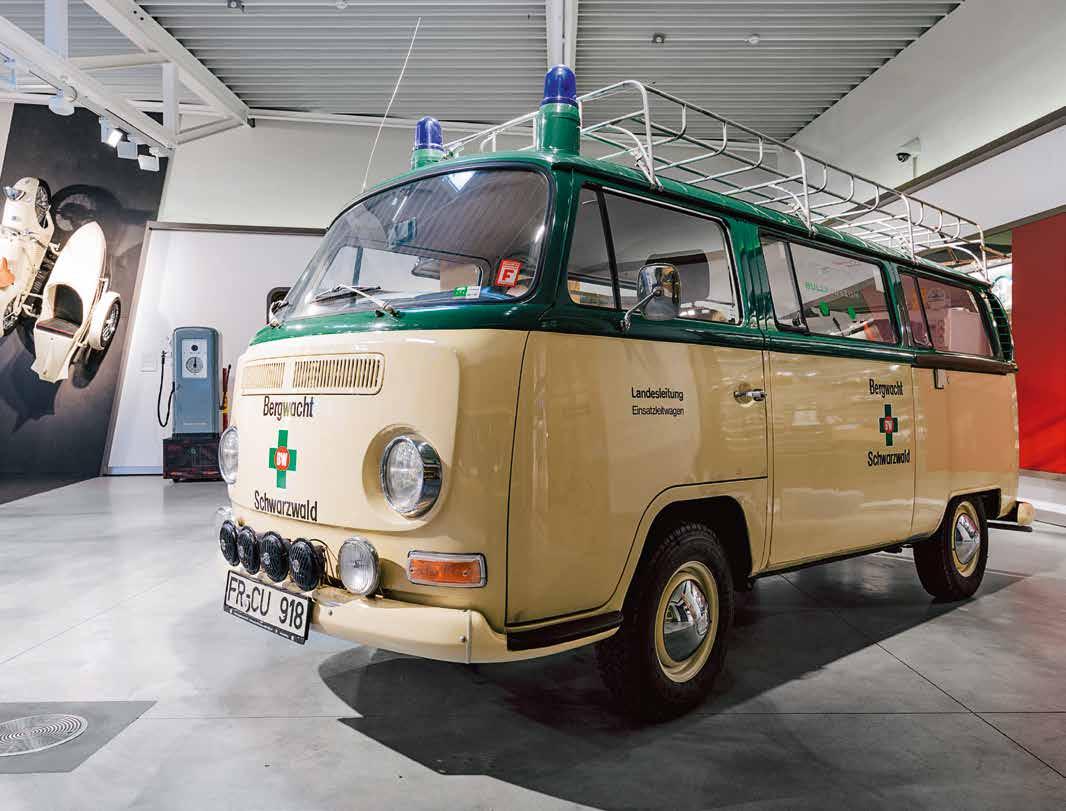
The second-generation VW Bus received a facelift in 1974. As with the T1, the indicators were a key differenti ator: the narrow strips just above the front bumper became practical, square diffusion lamps beneath the wind screen. The logo became smaller, and the steps for boarding were protected behind the front doors. The sliding door was also made quieter and easier to operate.
Soon, the van, pickup, double-cabin model, tipper and Kombi versions became available, as well as the top-ofthe-range Bus L. This passenger transporter, with much-improved features, was recognisable by numerous chrome additions. But the makers in Hanover were also thinking about special solutions, such as a school bus with room for up to 15 passengers, and an ambulance capable of carrying several patients. The engine got only a slight upgrade to 50 HP, but the later 70 HP engine powered the light Transporter extremely well. When used in conjunction with a three-speed automatic transmission, however, this additional power was lost: at that time, automatic trans missions did not equate to sporty performance!
When the T2 was phased out in Germany, Volkswagen launched its first limited special version of the Trans porter: 1,600 vehicles providing all that could be wished of a T2. Standard features included a huge sliding roof and tilting windows at the back. Premium upholstery, cladding, and matching carpet were also part of the offering. Everything was presented in a restrained dark blue to complement the metallic silver paint. Thanks to this exterior, the model is today known almost exclusively as the “Silverfish”, rather than the official title, “Lord of Hanover” –the latter intended to honour the city where the VW Bus came off the assembly line. No VW Bus was a lord, of course, but surely Hanover’s most famous citizen deserves an honorary title – or a monument at the very least.
The T2b can be recognised by the windscreen, still curved, and the square indicators beneath.
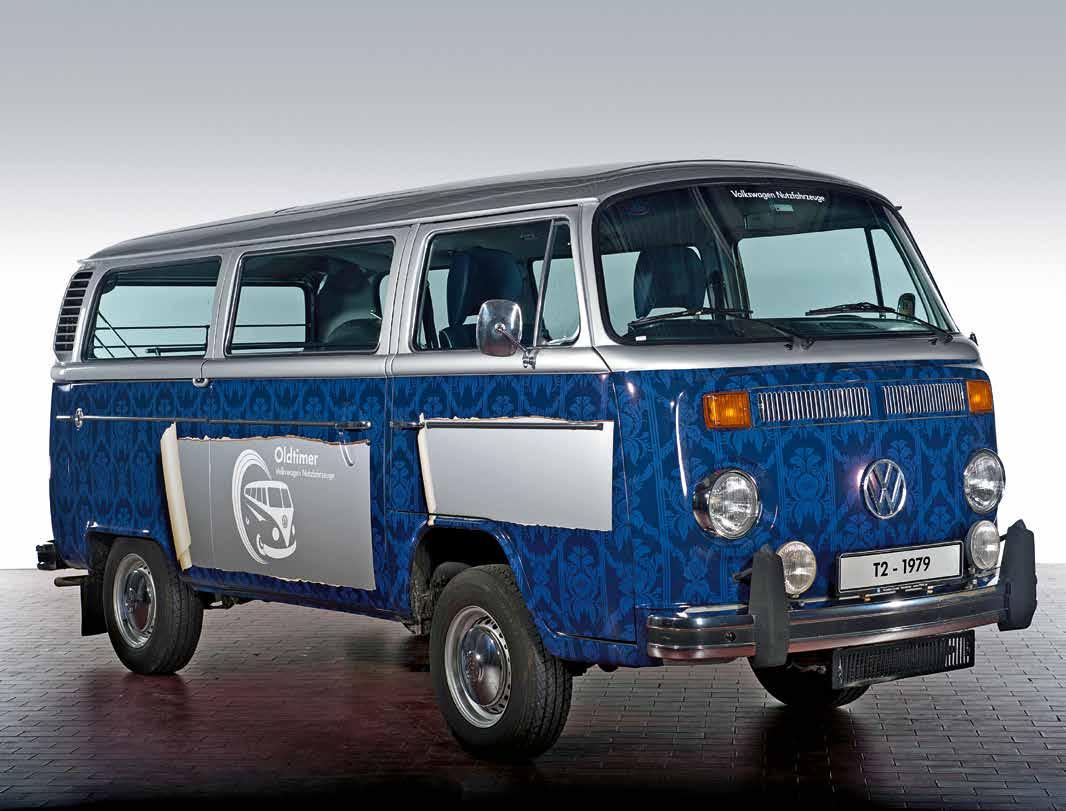
Although the VW Golf was launched with a water-cooled engine in 1974, for the Transporter the company stayed with an air-cooled rear engine. Engineers concluded that the time had not yet come for a front engine on the VW Bus, and that their concept for the T3 was the right way forward.
In principle, the concept was unchanged: the first row of seats is above the front axle, the engine at the rear, with cargo space between. From a technical standpoint, however, the T3 was a new design. Square bodywork, a so-called “one-box design” with clear corners and lines, appeared much more modern. VW was less progressive only where the engine was concerned.
Originally the range consisted of only two air-cooled petrol engines, with high consumption. Only with the installation of water cooling for the petrol and diesel engines was the VW Bus well powered – though the diesel version needed a turbocharger for the best combination of performance and consumption. When fitted with the 112 HP petrol engine, it was even suitable for urgent transport tasks. Engineers also improved the suspension and reduced the turning circle to 10.7 metres.
As with previous types, it was clear to VW that the T3 could only be successful if diverse customers were offered numerous versions. From the day of launch, there were once again van, Kombi, pickup and bus options. Although the T3 was repeatedly modernised with annual updates, it was never given a proper facelift. Nevertheless, in 1985 VW launched a vehicle that revolutionised the segment for small transporters: the Multivan. This spacious limousine, with a table and a bed, quickly found favour among families, the self-employed and sporting people.
The variations of use were simply inexhaustible, and the Multivan became synonymous with the VW Bus feeling –not simply an automobile, but a reliable partner to get away from the everyday grind.
The square T3 conspicuously differed from all other generations and only underwent small external changes during its lifetime.

It should really have happened at the change from the T2 to the T3, but 11 years later, VW Bus fans were still shocked: their much-loved automobile got a front engine. The drive was at the front, too, as a transaxle drive was complex and unnecessary. Although a few hard-core fans made disparaging comments about this change of concept, for Volkswagen it was necessary to keep up with competitors. With the T4, the VW Bus remained the benchmark in its segment, with no other vehicle of this type as pleasant and easy to drive.
Due to the front engine, the VW Bus now got a hood, and was visibly very different from its predecessors. This was undoubtedly one of the main reasons why some long-established customers had to get used to it. Yet this change had great benefits. In addition to a load space on one level, two wheelbase lengths could be offered without great cost. The long wheelbase made up for the length of loading area lost through the front engine, although as the total external length increased to a little over five metres, the vehicle was not easier to handle. This also gave the customer an even greater choice of models. Alongside the versions for transportation of goods, the Kombi, Caravelle and Multivan models for passengers were offered, of course. The latter was available as the Allstar special, with gaudy upholstery and enhanced features.
While engine performance was only a little superior to that of the T3 in the early 1990s, this changed radically with the introduction of the TDI in 1995. TDI became synonymous with sporty diesel-powered vehicles, and these engines were zippy, long-distance runners. Thanks to unprecedented acceleration combined with low diesel consumption, the TDI engine became the most popular powerplant for the VW Bus. With more than 1.6 million units sold, the T4 was extremely successful, despite the sceptics’ concerns.
For workers in manual trades especially, the front engine was an advantage, as it was now possible to load a completely level surface.

“We have made the number one even better,” proclaimed Volkswagen Commercial Vehicles in 1996 of their “orig inal” – the Transporter. After six years on the market, it was time for the first major upgrade. Externally, the new transporters and pickups were identifiable only by rounder bumpers and an air inlet on the mudguard, whereas the Caravelle, Multivan and California were given an entirely new front, soon known as the “Happy Face”, due to the friendly appearance of the new headlights and radiator grille.
The reworked model also received new engines. Alongside a soft-running VR6 petrol engine, the new diesel version was launched. With the introduction of a TDI version of the VW Bus, the engine could be considered truly powerful. At first it was only available with output of 102 HP and 250 Nm. With this powering it could zoom along an autobahn at almost 160km/h or, when driving economically, achieve a range of up to 1,200 kilo metres. If the owners took care to change the oil and drive belt in good time, the engines were good for distances of up to a million kilometres. The top performance was later increased to 150 HP (295 Nm) on the TDI, and 204 HP (245 Nm) on the V6 petrol model.
The inside of the T4 was reworked only slightly in 1996. The major upgrade to the dashboard did not occur until 1998. TV advertising of the day promised that not only dolphins were happy with the colour blue – and from then until 2009, the instruments on the VW Bus glowed blue, with red pointers. There were countless special models of the Multivan, right up to the Last Edition – a Highline enhanced by special features from the service centre. The most luxurious version of the T4, however, was the Caravelle Business, which was equipped with four indi vidual seats in the back, TV, video, telephone and fax, and with the whole interior clad in leather or Alcantara.
Many people thought the face-lifted T4 now looked much friendlier, and it also scored with its economical TDI engines.
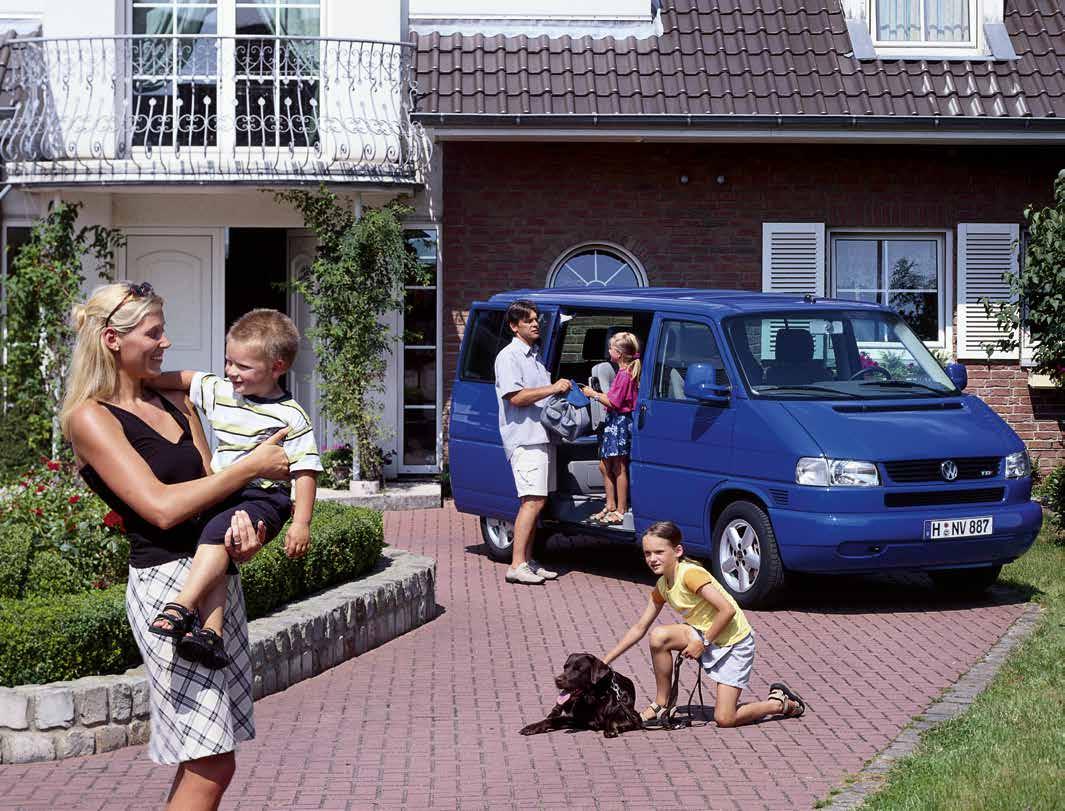
In contrast to the switch from the T3 to the T4, with the T5 there was no shift in concept. The change was much more than in appearance, however. The T4 remained a frontrunner in its segment both technically and in terms of quality, but competitors were catching up. Volkswagen Commercial Vehicles thus developed a successor that kept all the virtues of the VW Bus, but with a completely new design. The marketing team tried to suppress the name T5 – only the “new Transporter” and “new Multivan” were to be mentioned – but the terms T1 through to T4 were well established. Despite the manufacturer’s best efforts, customers and the media both talked of the T5 – and favourably, too, as the new model made a good impression.
The T5 did not feel like a sports car, but the new VW Bus was quieter, more comfortable and faster than its predecessors. The long gearstick between the front seats was moved to the dashboard, making it easier to change gear and to get into the back. The Transporter became more robust and practical, and set a new course for the Multivan. It gained a more upmarket dashboard, underlining its premium positioning. As well as a bottle compart ment, it had a glove compartment that kept chocolate cool even at the height of summer. The passenger cabin was perfect for large families. Up to four integrated children’s seats and blinds on the side windows as standard were also innovations.
Elements that were part of the concept since the introduction of the Multivan in 1985, such as bench seats that could fold into a bed, curtains and a table, were included. As a sliding door on the left side of the Multivan could be ordered for the first time, there was a new, movable, fold-out table between the rear seats. Due to its robot-like appearance, fans nicknamed it R2D2. With the T5, the VW empire was not only striking back, but taking the lead.
Striking lines, a joystick gear shift and the suspension of a saloon car made the T5 the ultimate limousine for travel. The Business model was the epitome of luxury.
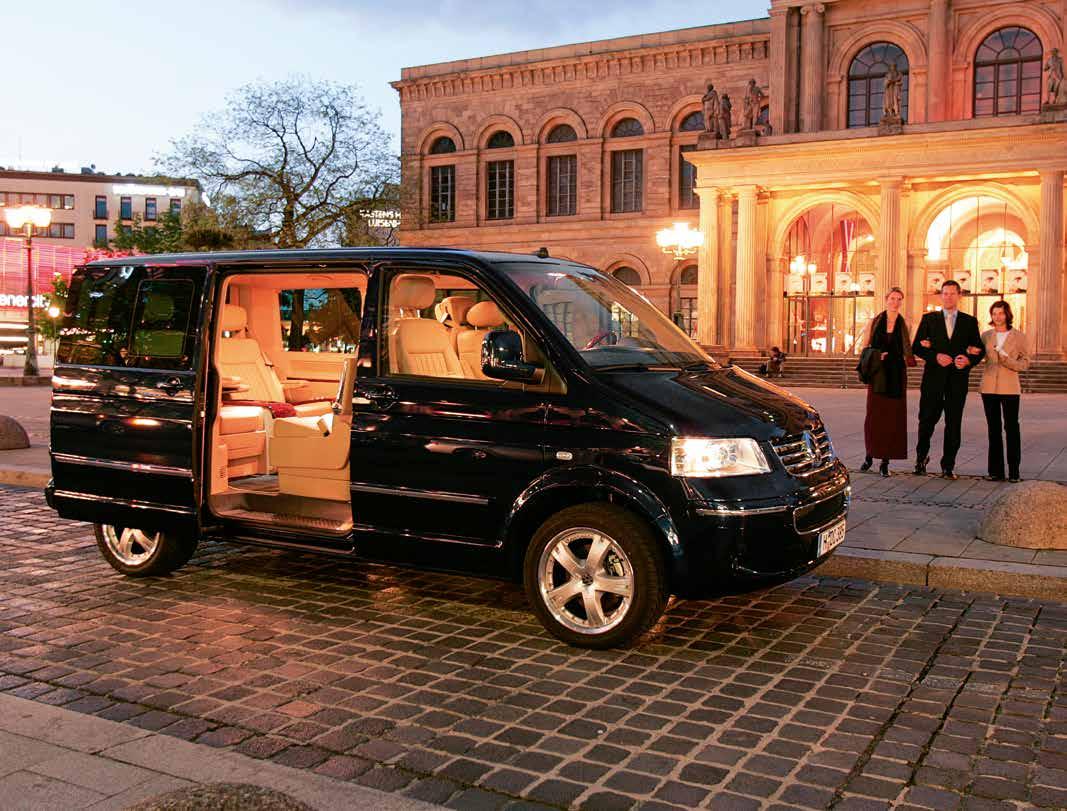
The VW Bus has never seen rapid changes to its design – a process known in the automobile trade as a “facelift” –but has always matured gradually. With the T5, six years passed before the manufacturer once again rejuvenated its bestseller. Although the bodywork remained unchanged, this amounted to more than the model’s annual renewal, and the company used the phrase “product enhancement” to refer to this upgrade.
Alongside new colours and fabrics, an updated dashboard was incorporated, allowing space for the radiosatnav from the latest VW cars. The new engines disappointed many fans, however. Instead of the much-loved 2.5-litre, five-cylinder TDI, which even powered the Touareg, there were only 2-litre, 4-cylinder common-rail TDI engines. On paper they were equally powerful, or in some cases generated higher performance with lower fuel consumption, but at first this went against the gut feeling of VW fans. A wide range was provided from the start, with four different TDI motors, from 62 kw/84 HP to 132 kw/180 HP. The new top engine had two turbochargers and impressive output of 400nm. This gave an overtaking boost that drivers loved. The big petrol version (150 kw/204 HP) lost not only power, but also two cylinders – and consequently some of its appeal with a change in sound.
An attraction for all thrifty drivers, by contrast, was the new BlueMotion: a Scrooge, with consumption of just 6.4 litres of increasingly expensive diesel for 100 kilometres. Purchasers seeking convenience were now offered, instead of a sluggish automatic transmission, a fast seven-gear dual-clutch transmission (DCT). This new tech nology made it possible to combine a four-wheel-drive VW Bus with DCT – there was no need now to choose between the two. In its fifth generation, “the original” continued to set both technical and emotional benchmarks, because a VW Bus is not merely used, it is loved.
With a front end that matched Volkswagen’s new design vocabulary, the reworked version of the T5 entered its second product cycle.
